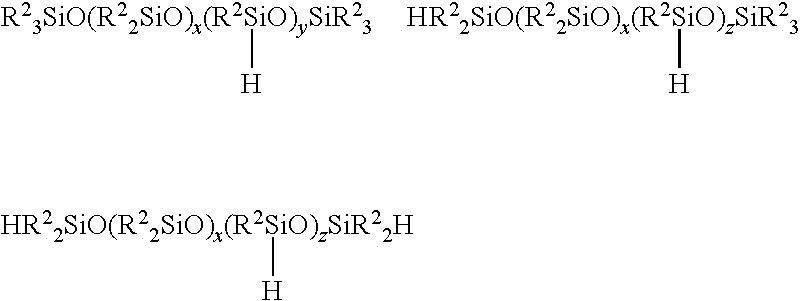Production Method Of Deoderized Polyoxyalkylene-Modified Polysiloxane Composition
- Summary
- Abstract
- Description
- Claims
- Application Information
AI Technical Summary
Benefits of technology
Problems solved by technology
Method used
Image
Examples
production example 1a
[0127]A bottle holding 100 mL of the ultrahigh purity alcohol (A) was unsealed and 4.30 g special reagent grade trichloroacetic acid was immediately added to the bottle. The bottle was then re-capped and was thereafter mixed by shaking to achieve uniformity and produce an alcohol solution of trichloroacetic acid that had an acid concentration of 4.3% (wt / vol). This solution was designated as “trichloroacetic acid solution (1A)”. This production process was carried out within one hour prior to the absorbance measurement.
production example 2a
[0128]A bottle holding 100 mL of the ultrahigh purity alcohol (A) was unsealed and 50 mg 2,4-dinitrophenylhydrazine (special reagent grade product containing an equal amount of water, referred to below as “2,4-DNPH”) was immediately added to the bottle. The bottle was then re-capped and the 2,4-DNPH was completely dissolved in the ultrahigh purity alcohol (A) by holding for 5 minutes in an ultrasound cleaner to produce an alcohol solution of 0.025% (wt / vol) 2,4-DNPH. This solution was designated as “2,4-DNPH solution (2A)”. This production process was carried out within one hour prior to the absorbance measurement.
production example 3a
[0129]A bottle holding 100 mL of the ultrahigh purity alcohol (A) was unsealed and 4.0 g potassium hydroxide (pellets, special reagent grade) was immediately added to the bottle. The bottle was then re-capped; mixing by shaking was performed until the pellets had disappeared; and the potassium hydroxide was then completely dissolved in the ultrahigh purity alcohol (A) by holding for 10 minutes in an ultrasound cleaner to produce an alcohol solution of 4.0% (wt / vol) potassium hydroxide. This solution was designated as “potassium hydroxide solution (3A)”. This production process was carried out within one hour prior to the absorbance measurement.
[0130][Measurement of the Carbonyl Value]
[0131]2.00 g sample and 23.00 g ultrahigh purity alcohol (A) were introduced into a 50-mL screw-cap bottle and were mixed to prepare 25.00 g of a sample solution (Sa) having a sample concentration of 8 mass %. The compositions obtained in Comparative Examples 1, 3, 4, 5, and 6 had very high carbonyl val...
PUM
| Property | Measurement | Unit |
|---|---|---|
| Temperature | aaaaa | aaaaa |
| Mass | aaaaa | aaaaa |
| Volume | aaaaa | aaaaa |
Abstract
Description
Claims
Application Information
 Login to View More
Login to View More - Generate Ideas
- Intellectual Property
- Life Sciences
- Materials
- Tech Scout
- Unparalleled Data Quality
- Higher Quality Content
- 60% Fewer Hallucinations
Browse by: Latest US Patents, China's latest patents, Technical Efficacy Thesaurus, Application Domain, Technology Topic, Popular Technical Reports.
© 2025 PatSnap. All rights reserved.Legal|Privacy policy|Modern Slavery Act Transparency Statement|Sitemap|About US| Contact US: help@patsnap.com



